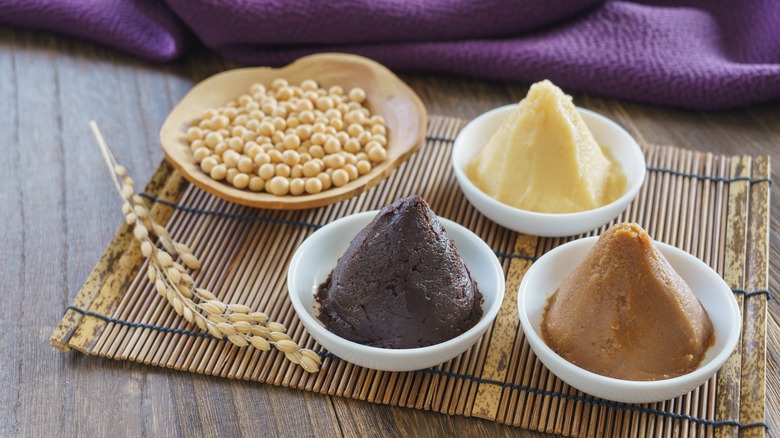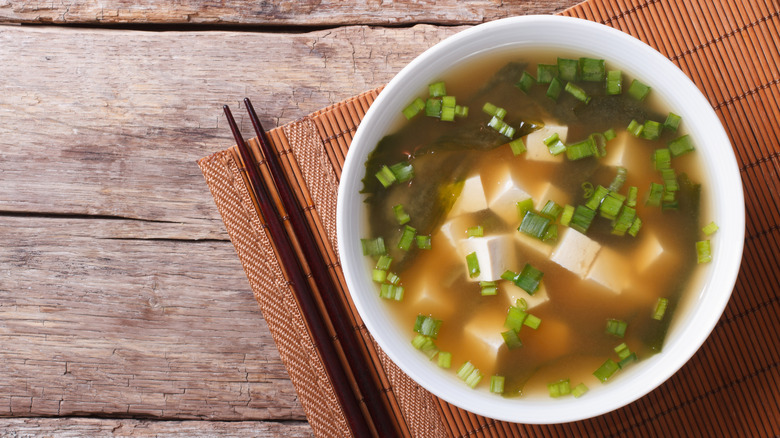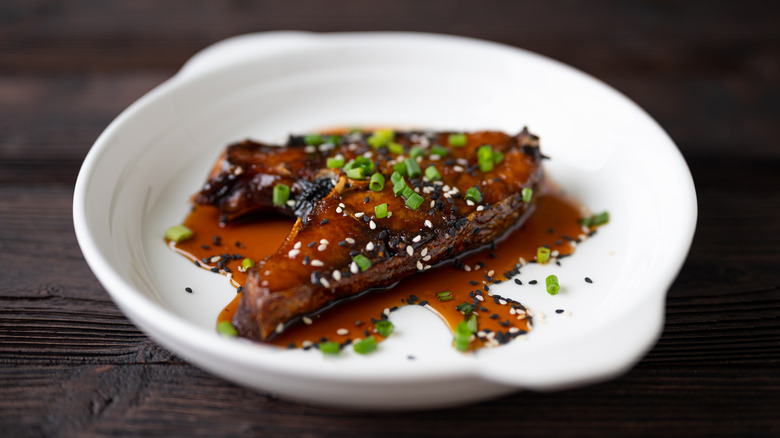What The Color Of Miso Paste Says About Its Flavor
Miso paste is a condiment that you've probably seen in your local Asian grocery store or as a listed ingredient in dishes like stir-fries, marinades, or soups. This paste is made from fermented soy beans, salt, and koji, which is a cooked grain (usually rice)that helps kickstart the miso fermentation process. Miso paste might seem daunting if you've never cooked with it before, but once you know the basics, this salty, umami filled condiment can add a depth of flavor to endless recipes in your kitchen.
If you've bought miso paste before, you'll know that it is often sold in different colors. It might seem a little overwhelming, but there's a simple way to distinguish what the color means for the miso flavor. Miso can usually be categorized in one of three colors: white, yellow, and red. The darker your miso paste is, the more intense and salty its flavors will be. Darker pastes have been fermented for longer, which is what brings a deeper flavor and color to this variety.
The different colors of miso paste
Starting with white miso — also known as shiro miso — this is the mildest flavored paste of the three. Its color can vary from white to pale beige, and its flavor is sweet with hints of umami. White miso only takes 2 to 8 weeks to ferment using a high rice content, making it less salty and mild. The milder flavor profile of white miso makes it perfect for lighter dishes like soups, or salad dressings. This is also a good miso paste to grab if you're using it for the first time.
Next on the list is the more flavorful yellow miso, known as shinshu miso, which can also be light brown in color. This type of paste has been fermented for up to 6 months with more barley and less rice, which gives it a saltier, earthier taste. Yellow miso contains similar flavors to white miso but with more pronounced umami notes, making it a great all-round paste for condiments, marinades, and soups.
Red miso aka (just) miso, can range from red to dark brown in color, and is by far the strongest in flavor intensity. Red miso is fermented for 12 months or more, and made with a higher amount of soybean, which is what gives it such an intense flavor kick. This paste as a bold umami flavor and more complex taste, which is why it should only be used in richer dishes. Rich glazes or hearty stews are perfect for the boldness of red miso.
Serving suggestions for each miso type
Even if you understand the flavor differences of these three miso pastes, it can be hard to know which paste works best in which dish. A good rule of thumb is to pair a lighter colored paste with lighter flavored dishes, and darker colored paste with heavier dishes. Try adding white miso paste to any light soups such as Swedish fish soup, or homemade chicken soup. Add around 1 tablespoon per cup of liquid broth, at the end of the cooking process, adjusting to taste. This is a great way to add a hint of umami without overpowering your dish.
As yellow miso is quite versatile and has a mix of sweetness and stronger umami flavors, there are plenty of dishes to add it to. Consider adding a few tablespoons of yellow miso to your next sweet and spicy steak and other meat, or fish marinade. Yellow miso will elevate and add depth to your marinade with pronounced earthy, umami flavors. If the marinade recipe contains salt or other high sodium ingredients, either reduce those ingredients or replace entirely with miso paste to avoid over salting.
Red miso paste is perfect in heavier winter foods, like beef or bean stew. Red miso will accentuate the already strong and rich flavors present in these dishes. Start by adding a few tablespoons of red miso paste to your stew, adding more if necessary. Make sure to omit or heavily reduce any other sodium based ingredients.


